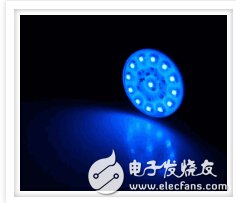Increase knowledge! How to evaluate LED strobe?
Do you have such a discovery? When we read a book under fluorescent light for a long time, the eyes are easily uncomfortable, even if the brightness of the fluorescent lamp is no different from the daytime.
Why is that? Experts have found through research that this is mainly because the light intensity of the fluorescent lamp changes with time, which makes the human eye feel uncomfortable. In short, the flickering of the fluorescent light source can cause discomfort to the human eye.
What is strobe?
When it comes to the flicker of the light source, we often use the word "strobe". So, what is strobe?

Strobe, as the name implies, is a flicker that occurs due to frequency.
The stroboscopic phenomenon of the light source means that the light emitted by the light source changes rapidly and repeatedly with time, which makes the light source jump and unstable, that is, the depth of fluctuation of the luminous flux of the electric light source. The greater the fluctuation of the luminous flux, the more severe the stroboscopic. The essence of stroboscopic light source is the fluctuation of luminous flux. Under the driving of AC or pulsed direct current, the luminous flux, illuminance or brightness change with the periodic variation of the current amplitude. The human eye to the human brain produces this change. Subjective response. The depth of fluctuation of the luminous flux of the electric light source is directly related to the technical quality of the electric light source.
The stroboscopic effect needs to be distinguished from the stroboscopic effect, which refers to the harmful effect of the electric light source caused by the fluctuation of the luminous flux, that is, the harmful effect caused by the stroboscopic. The more severe the strobe of the electric light source, the more serious the stroboscopic effect is. The stroboscopic and stroboscopic effects are two mutually causal physical quantities that characterize the magnitude of the electric light source, the fluctuation depth of the luminous flux, and the resulting hazard effect (called the stroboscopic effect), that is, stroboscopic causes the stroboscopic effect.
Light source strobe hazard
Nowadays, people not only pay attention to the physical performance effects of lighting, but also pay attention to the photobiosafety of lighting. The strobe of the light source is irritating to the human visual system and creates an uncomfortable feeling. Usually, the flicker is divided into visible flicker and invisible flicker according to human feelings. When the frequency is greater than 100 Hz, the human eye does not feel the flickering phenomenon, but it still causes eye fatigue, headache, etc. This is the result of stroboscopic light. It is generally believed that this effect exists within 500 Hz.
People who work or live in the blinking light for a long time may also affect the physical and mental health of the visual system. The severity of this stimulating effect or effect is related to the intensity, frequency, duration of action, and long-term nature of the source's flicker. This effect is often slow, so it has not attracted people's attention for a long time. The stroboscopic and stroboscopic effects of electric light sources have brought serious harm to our work and life. So what harm does stroboscopic cause to the human body?
The impact of light on human health is a long-term, chronic accumulation process, and developed countries in the world have started relevant research very early. According to different factors such as the flickering frequency of light and the variation range of light intensity, the degree of damage of light to the human body is also different. The results of the current study found that the stroboscopic effect causes adverse physiological responses in the human body including:

Headaches and eye strains Dr. Wilkins et al. found that office workers used high-frequency electronic ballast luminaires to reduce their headaches by two times compared to those with 50 Hz magnetic ballasts. According to the National Headache Foundation's report: "Many migraine patients are very sensitive to light, such as light and flicker, which is more likely to cause migraine. Slow blinking is usually more likely to cause migraine than fast blinking."

Photosensitive epilepsy in people with light sensitivity in the range of 3-70HZ under visible light modulation, even a short period of exposure can occur epilepsy, which probably affects 1 / 4000 of the age of 5-24 years old, usually in adolescence The onset begins and ends, and 75% of the population will be sensitive to light throughout their lives.

Vision loss Veitch and McColl discovered in 1995 that a 100-120 Hz modulated inductive ballast fluorescent lamp system would reduce the average visual acuity of a population compared to high-frequency electronic ballasts. This often happens in paper reading and text reading on computer screens.

• Attention is scattered around the field of view of the human eye to be more sensitive to strobe, such as strobe lights or rapid modulation of the taillights of the car will attract drivers to stare at it. Removing your eyes in advance may be dangerous for drivers or people and things driving on the road. The stroboscopic light source combined with the running machine produces an opening and closing effect, and the damage to the person can result in significantly different movement and stopping speeds. This hazard has been identified in the industry ten years ago.

Children with autism with autism are particularly sensitive to changes in the environment, and stroboscopic lighting increases the recurrence of this behavior. The proportion of children with autism in the United States is about 1/110.
Our favorite cells for ebike battery packs are Panasonic GA, Panasonic PF, Samsung 25r, and Samsung 30q. We use state-of-the-art BMS with temp control to keep your battery as safe as possible ( read article on ebike BMS) We are hazmat certified to ship our battery packs and all our packs are tested and certified (UN38.3) to be shipping safe.If your ebike battery is discharging at 200W for an hour, it`s used 200Wh. If that same battery is discharging at 200W for 2 hours, it`s used 400Wh. Now you know the important terms let`s learn some more about ebike batteries! There`s quite a few types of battery that you could power your ebike with. Some of the most common battery types include:We use only authentic name-brand cells (Panasonic or Samsung) made with the best BMS and the best ingredients. Our favorite cells for ebike battery packs are Panasonic GA, Panasonic PF, Samsung 25r, and Samsung 30q.Picking The Type Of Battery. There`s quite a few types of battery that you could power your ebike with. Some of the most common battery types include: Lead acid. Nickel-cadmium. Nickel-metal-hydride. Lithium-ion.
48v replacement ebike battery,48v replacement ebike battery
Shenzhen Glida Electronics Co., Ltd. , https://www.szglida.com